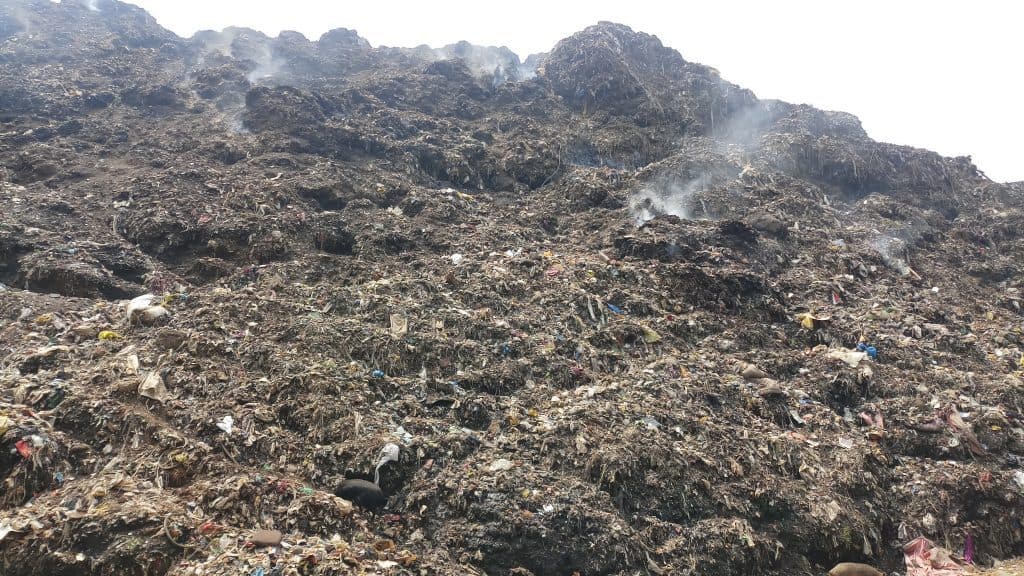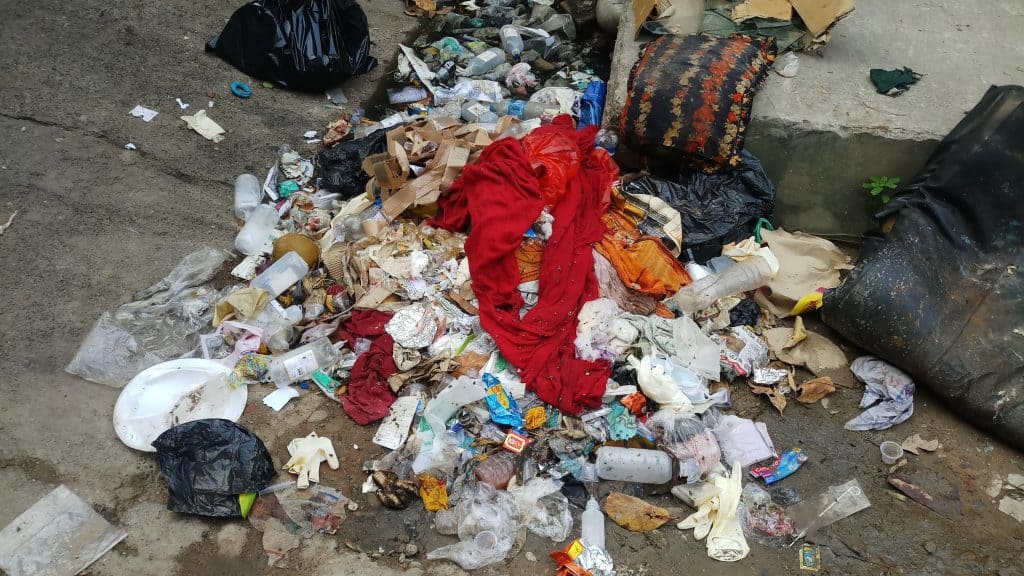Milan Bhowmick has been farming on his two acres of land in the East Kolkata Wetlands for over thirty years now. He grows brinjals, cauliflower and other vegetables. His land lies close to the Dhapa dumping ground where the solid waste of the city is dumped.
The 45-year-old says that the solid waste from Dhapa was composted to produce fertilizers for the farm even till a few years ago, but the increasing presence of plastic and other toxic waste in the dump has now forced him and other farmers to discard the practice.
“A proper mechanism to deal with the waste collected from the city might have proved helpful to us, but the entire waste is brought and dumped here without any segregation. The solid waste is then collected by scrap dealers who have set up units for their segregation and recycling right here on the wetlands, which therefore face the double whammy of pollution and encroachment. It is just a matter of a few years, and these natural lungs of the city would be dead forever,” said Milan, pointing to the large multitude of houses and shops that have cropped up on lands that were once lush green fields.
The fact is that Kolkata, one among the most affordable cities in the country, has also seen a spike in consumerism and is struggling to deal with the solid waste menace, thanks to the apathy of the administration that has never considered it an important enough issue.
Tonnes of waste but no mechanism to adhere to the rules
According to senior officials of the Kolkata Municipal Corporation (KMC), the city generates around 4500 metric tonnes of solid waste every day from its 144 wards and almost the entire waste is dumped into the Dhapa grounds virtually without any segregation at the origin.
The KMC officials, however, say that they have recently started waste separation in eight wards of the area under their jurisdiction by distributing colour-coded bins to the citizens. On February 20 2019, Mayor Firhad Hakim handed over colour-coded waste bins to residents of Chetla in south Kolkata, marking the formal introduction of waste segregation at source in the city. Each recipient was given a green bin for biodegradable waste and a white one for non-biodegradable and recyclable waste.
“We have already started the pilot project in eight wards. We will soon extend it to other wards,” said Subhasish Chattopadhyay, DG. Solid Waste Management, KMC. However plans for the existing dump at Dhapa seem tentative at best.
“A private company in Dhapa — the Eastern Organic Fertilizer Private Limited(EOFPL), set-up in 2000 — now processes and converts 500 metric tonnes of solid waste into organic waste everyday, but the dumping ground is filled to its brim. We are looking for new space, possibly in the Rajarhat area,” added Subhasish. According to a December 2018 report, the new facility will be an engineered landfill site, where the methane trapped in food waste will be collected and disposed of through pipes so that the chances of fires are eliminated.
Environmental activists, meanwhile, dismiss the recent efforts of the KMC as a mockery of the existing Solid Waste Management Rules 2016, which divides waste into six categories and lays down rules for disposal of each type. The law categorises waste into plastic waste, e-waste, bio-medical waste, construction and demolition waste, hazardous and municipal waste. There are no provisions for a dumping ground, but only sanitary landfill of such waste that cannot be recycled under any of the six categories specified.
“But the KMC is looking for a fresh dumping ground that is in gross violation of the rules. They claim to have started a pilot project by distributing bins in eight wards only. When it is compulsory by law to separate the waste at the origin, why not implement the project across the city, rather than start a pilot project just to impress people ahead of polls and get their votes,” fumed Naba Dutta, secretary of Sabuj Mancha, a civil society organization working to create awareness on environment.
At the receiving end
Travel around the city and you will come across several pockets that are facing the brunt of the lack of segregation of solid waste. Nearly 600 employees of Nonapukur tram depot, the tram workshop in central Kolkata, are struggling to deal with the waste dumped outside the workshop.
“It is really difficult to even sit here for a minute with windows open. The stench from the rubber and other waste dumped by the shops of scrap dealers outside the workshop has made our lives hellish. It would have been better had they kept covered bins for the waste but it lies scattered in the open. We have informed the authorities several times in the past but to no avail. The waste is even affecting our health,” said a senior employee at Nonapukur requesting anonymity.
Neighbour’s woes
Even Howrah Municipal Corporation (HMC), the twin municipality of Kolkata, follows no procedure for dumping solid waste. The 500 metric tonnes of waste generated every day in Howrah (including Bally) is dumped at Belgachia, on the fringes of Kolkata, where you can clearly spot 60 ft tall mountains of waste from a distance. Pigs are seen swarming near the mountains and feeding on the waste.
In 2015, HMC had inked a deal with a German company to build a Rs 3,400-crore plant at Domjur in Howrah to generate electricity from this mountain of garbage. The project was supposed to be the first of its kind in the country but it failed to see the light of the day,
“The project didn’t take off for several reasons. We have no treatment plant and collected waste is being dumped at Belgachia without any separation,” confirmed Gautam Choudhury, Member, Mayor-in-Council (MMIC), Conservancy, HMC.
Loopholes in disposal of bio-medical waste
The problem, however, is even more worrying when one looks at the disposal of bio-medical waste in the twin cities.
According to the Biomedical Waste Management Rules 2016, biomedical waste must be divided into four categories and disposed of in colour-coded boxes. However, many activists claim that bio-medical waste in the city is being dumped illegally by keeping all norms at bay.
“Syringes, saline bottles and gloves that should be destroyed after use are being callously dumped, and then re-sold illegally. This puts the lives of several people, including waste handlers, at risk. The lack of monitoring by government agencies has been encouraging wrong-doers to continue without any fear,” said Sasanka Sekhar Dev, Founder of DISHA (Society for Direct Initiative for Social and Health Action), a non-profit working for environment.
His words finds resonance when you visit the Howrah district hospital premises,where discarded syringes, gloves and saline battles lay outside in the open. When confronted, hospital authorities assured that they would soon be removed and assured strict action against those found guilty of dereliction of duty.
Even the company officially involved in processing the bio-medical waste from Howrah and north Kolkata conceded that there may be some waste which is not being burnt or recycled as mandated.
“We collect around 7.5 to 8 tonnes of waste every day from 1200 collection points in the city that includes 100 government hospitals. The incinerable waste is burnt at a temperature as high as 850 degrees while others are shredded and sent to authorised recyclers as identified by the Central Pollution Control Board in Delhi. It is true, however, that some of the private or smaller nursing homes running illegally may be involved in nefarious practises or re-using it. But they are just a small fraction,” said a senior official of Medicare Environmental Management Private Limited.
Indifferent leadership
At the end of the day, it is the laxity of authorities and the lack of monitoring that is at the root of the waste crisis. “Our leaders have always ignored the important issue regarding the disposal of solid and bio-medical waste. Several projects are announced with much fanfare before polls but they are put in cold storage eventually,” said Samir Verma, a young citizen.
“We have realized that none of the departments of the state government is serious in implementing the Solid Waste Management rules of 2016. They have only paid lip-service so far. The introduction of boxes in some wards to segregate the solid waste, as part of a pilot project, is just a hoax; the need of the hour is to segregate solid waste at source, across the city. Forget enforcement and monitoring of segregation, they have also not paid any attention to open burning of waste and leaf litter around the city, which is a major source of air pollution,” said Naba Dutta, expressing anguish at the continuing negligence of the authorities regarding solid waste.
| This article is part of a series produced under the Citizen Matters – Sustainable Cities Reporting Fellowship , supported by Climate Trends. |

